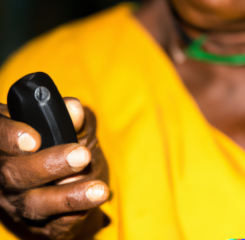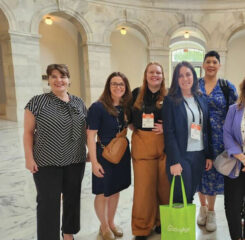Brandy Stefanco, CFO, Jewish Home Family
Brandy, thanks for taking time to talk to us today. How about we start by you sharing with us a little bit of about yourself, your career so far, all the way to being CFO to Jewish Family?
Brandy Stefanco: When I think about my career and where I’ve been, I really think it started in my home. I grew up in a multi-generational family I became very close to my grandmother and so I started volunteering with older adults and in nursing homes at a very young age and realized that I really enjoyed helping people and being there for them and being able to support them and I think that’s really where I started on my path.
I started working in an activities department and moved into the finance office and became a regional accountant and a comptroller. I found the Jewish Home Family about 15 years ago, where I joined them as their chief financial officer and I find that I still get to help older adults but in a really different way. I get to make sure that the organization that’s there supporting them now we’ll be there in 20 or 30 or 100 years from now.
So, that’s really how my journey has progressed.
Tell us a little bit about Jewish Home Family and what’s the most exciting thing that you folks are working on?
Brandy Stefanco: The Jewish home family celebrated, well we’re in our hundred and the first year of operation. It started out really as a home for the orphans and has kind of progressed through time to really become a premier agency that helps older adults.
We have a 180-bed skilled nursing facility. We opened an assisted living facility about 10 years ago. We have a home and community-based service arm that really provides medical Adult Day services. We have care management. We recently opened a home health agency and it’s really in that community-based section of our organization that we’ve really started to look to technology and started to find ways that we can help older adults remain safe in their home environment so that there’s less dependence on our facility settings and that we can really meet our older adults where they live.
We’ve started to experiment with sensor technology just from a home modification perspective to make sure that you know all of their home environment is safe and that things aren’t leaking and that water pipes aren’t breaking, that maybe they’re not even aware of.
We’ve recently implemented drivers’ assessment programs, it’s a simulator program that really starts to gauge the response time from the brain to the foot to the gas pedal to the break and then compare it against norms and it helps us to provide a sense of safety and security not only to the older adult but to their families as well.
We have done stuff with medication management, we actually did a beta test with PointClickCare and while it actually was not as successful in our community, I think it actually gave them a lot of insight into the different communities that are out there you know. We are in a higher scale community that does have a lot more home resources and the beta test that we did with them actually was not as successful and I think it gave them some of the challenges that they still need to work through. So, I think while it wasn’t successful it was successful at the same time.
As a CFO how do you see the role of technology playing in the way you provide services as well as what is your overall view of technology from a CFO when you wear the CFO hat?
Brandy Stefanco: I think technology is vitally important and I think there are two different avenues that it’s vitally important. From the CFO perspective, I think you know they talk about the data and having access to that data and being a chief financial officer I think it’s my job to make sure that I have access to that data. That I understand what it means, that I understand what the trends are that are happening within our facilities and in our communities so that I can start to financially gauge and strategically plan for the future. What types of residents are we seeing in our buildings? What are the costs associated with those? I think right now for our industry that’s actually one of the biggest challenges is that we have the data but being a smaller organization our ability to dig down into that data.
It’s a challenge; we don’t have the same sophisticated systems that a hospital system may have or there’s not quite the same focus that maybe even a physician group has and so you know we need to look and understand that data so that we can really understand what the future costs are going to be as our population ages and as the population grows even? What kinds of people are we going to be seeing in the future?
From a mission perspective, I also think that technology is vitally important, you know we have one of the biggest challenges even in our own facility when you transition into a nursing home or you transition into an assisted living, you have a loss of community, you’re moving into a different type of community. But the things that you could do when you live at home aren’t necessarily the same things you can do in a traditional nursing home setting, and so I think it’s important for us to invest into things like Broadway HD which allows our residents to in real time see Broadway performances. That’s something they did in their real life when they lived out in the community and so we’re able to bring that to them so they can have that same continuity and that same cultural experience. We’re doing a very similar program with the Cleveland Museum of Art, we have access to a curator.
Our residents choose the artwork they want to see, it’s kind of a Skype or FaceTime technology where they interact in real-time, can ask questions and it brings that same community feeling into our home as opposed to being out. And I think it’s important to invest in those [technologies] because you know that loss of community leads to depression and it leads to other things that can happen to the individual and you know we, as an organization, need to make sure that we are bringing them the same vibrancy they had while living outside.
You’ve been working with LeadingAge CAST for some time, so how is CAST helping you folks in looking at these technologies, evaluating them both financially as well as otherwise?
Brandy Stefanco: We’ve been with CAST, I guess, about a year and a half two years now, and one of the first things we got out of CAST was the ability to do that beta test with PointClickCare I had the opportunity to attend a luncheon and they were there and they had acquired a telehealth vendor and I thought well that’s something we need to be a part of.
And I really believe that was something we should be bringing to our community and so I was able to make that connection and I think without CAST I wouldn’t have been able to do that. I also think being a smaller organization I’m able to leverage what they’re doing that I would not otherwise be able to do; so if I have questions or I’m wondering what other people are doing or how are they addressing issues I have a whole network of really intelligent IT people I can reach out to, because our particular company doesn’t have a large IT infrastructure, we don’t have a dedicated CIO, you know, I wear that hat on a lot of occasions and CAST has been invaluable from that perspective.
Brandy, how about we close with some advice from you? There are a lot of young healthcare executives that look up to somebody like you and say how do I become the next Brandy. So what’s your advice to them?
Brandy Stefanco: My advice is, you need to find what your passion is, and then once you know what your passion is, you need to align yourself with an organization that has that same passion and I think the melding of those two things will just push you, to want to do more and want to be better and want to learn more and I really think that’s the best advice.
That’s great advice Brandy, thank you so much for taking time to share your wonderful insights with us. Really appreciate it, have a wonderful rest of the day.

Most Recommended
February 29, 2024
Say Yes to Lobby Day!
April 05, 2024
Cyberattack Updates: Change Healthcare Payment Platform
April 22, 2024
 Nursing Home Staffing Ratios: LeadingAge Is On the Case
Nursing Home Staffing Ratios: LeadingAge Is On the Case
March 27, 2024
 Colleagues on the Move, March 27, 2024
Colleagues on the Move, March 27, 2024
April 12, 2024
Improving Medicare Advantage
Recently Added
April 22, 2024
CAST Safety Technology Selection Tool Updated
April 22, 2024
CAST Members in the News
April 22, 2024
Mental Health Training for HUD Service Coordinators
April 19, 2024



